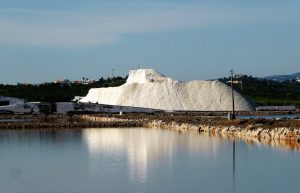Once a considered a precious commodity, salt is now commonly available. We crave salty taste and use it to flavor our food and nourish our bodies.
The adult human body has about 250 grams of salt in it. That’s equal to about 4 salt shakers.
On the average, adults consume 3,400 mg. of salt daily and most of that intake is from the restaurant meals and processed foods we eat. Experts agree that it’s best to limit sodium to less than 2,300 milligrams a day. One teaspoon!

[alt tag/] Salty French fries.
Why would a person want to eat a rock?
We actually need salt in our diets. Our bodies don’t produce it so we add it to our diets.
Salt aids in the body’s fluid balance as well as its muscle and nerve function. Salt is lost through body functions and we need to replace it.
The chloride salt provides is essential to our respiration and digestion. Even though the human body does not manufacture sodium, it needs it to carry important nutrients, oxygen, nerve impulses and to move muscles (including the heart).

[alt tag/] Himalayan salt contains 86 minerals
Health experts differ in opinion about how much salt a person needs to be healthy. Recommendations for annual salt intake range from two-thirds of a pound to more than sixteen pounds per year. Needs vary depending on the climate we live in. People who live in hot climates or who do physical labor will need more salt to replace what is lost through sweating.
We eat for energy and will customize our nutritional choices from there. One person may eat for mental clarity and they’ll make choices like fatty fish, flax seeds, leafy green vegetable and the like. Someone else may struggle with arthritis or fibromyalgia pain and use their diet as a way to have a better quality of life. They will limit tomatoes, artificial sweeteners and sugars from their diets and find benefit.
Whatever focus we have with our diets; we all need to eat salt in order to be healthy.

{alt tag/] Salt crystal
What is salt?
The mineral salt is one sodium ion and one chlorine ion. It is 40% sodium and 60% chloride by weight.
In chemical terms, salt is the substance produced by the reaction of an acid with a base. When the unstable metal sodium, (which can suddenly burst in to flames), is combined with the deadly poisonous gas chlorine, it becomes the food staple we call sodium chloride, or NaCl.
It is from the only family of rocks eaten by humans!
Of the many different salts, the one we most enjoy eating and identify as ‘salty flavor’ is sodium chloride. Many of the other salts will convey a bitter, sour or other unwelcome taste, though they contribute value to the human diet.

[alt tag/] Coarse white rock salt on the rim of an icy margarita glass with sliced limes.
Salt mining and control of the commodity is directly linked to powerful trade destinations throughout history. We needed salt to preserve foods. The more food a country could preserve, the farther their explorers and armies could travel and enrich their homelands.
Salt is Everywhere.
Woven through our civilized history are salt mines. The control and distribution of salt created wealth and influence. It’s only been 115 years or so since refrigeration came along and changed the way we store foods.
Not so long ago, we didn’t know how to find the salt we needed and it was a treasured commodity. Now, modern geography has shown us the many places it can be found.
At one time, salt was traded in equal weight for gold!

[alt tag/] Sea salt evaporation mine
Salt is mined in an evaporation pond on the seaside. It’s mined on the mountainside terraces in Peru. We treasure the salts of ancient sea beds, mined from deep underneath mountains in Europe or Pakistan.

[alt tag/] Inside the beautiful and historic Wieliczka salt mine in Poland.
There are magnificent old salt mines that have been made into beautiful places of gathering, dining and healing.
Salt is everywhere and we love it.
The next time you sprinkle a little rock on your food… think about that one teaspoon a day!
 This writing is an example of a 500-700 word informational article.
This writing is an example of a 500-700 word informational article.